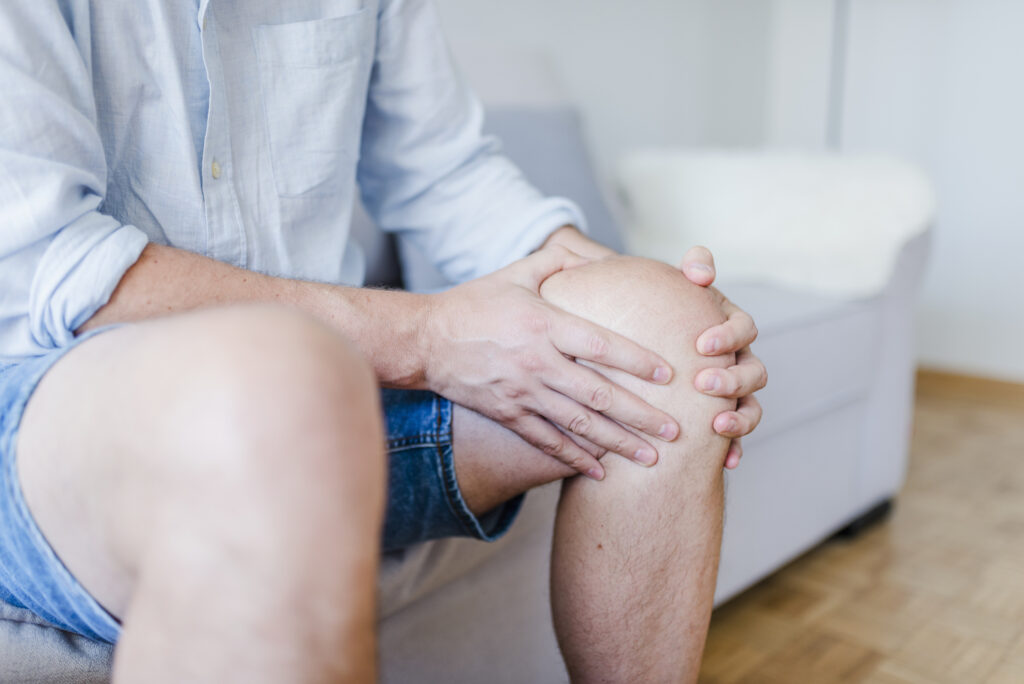Knee bursitis is a common yet often misunderstood condition that affects many people, particularly those who engage in repetitive knee movements or put prolonged pressure on their knees. Understanding the relationship between inactivity and knee bursitis is crucial for effective management and prevention of this painful condition. In this blog post, we will explore whether inactivity exacerbates knee bursitis and discuss how integrated care from chiropractors and physiotherapists at CARESPACE can help manage and alleviate this condition.
Understanding Knee Bursitis
Knee bursitis occurs when the bursae, small fluid-filled sacs that cushion the bones, tendons, and muscles near the knee joint, become inflamed. This inflammation can cause pain, swelling, and limited movement. Bursitis can be caused by various factors, including repetitive motions, prolonged pressure on the knee, injury, or underlying conditions such as arthritis.
Common symptoms of knee bursitis include:
- Pain and tenderness around the knee joint
- Swelling and warmth in the affected area
- Stiffness and difficulty moving the knee
- Increased pain with activity or pressure on the knee
The Role of Inactivity in Knee Bursitis
Inactivity can have a significant impact on knee bursitis, often leading to worsening symptoms. While rest is essential during the acute phase of inflammation to reduce pain and swelling, prolonged inactivity can have detrimental effects on the knee joint and overall health. Here’s how inactivity can make knee bursitis worse:
1. Muscle Weakness and Imbalance: Prolonged inactivity can lead to muscle atrophy and weakness, particularly in the muscles surrounding the knee joint. Strong muscles are essential for supporting and stabilizing the knee, reducing the stress on the bursae. Weak muscles can lead to an imbalance, placing additional strain on the knee joint and worsening bursitis symptoms.
2. Joint Stiffness: Lack of movement can cause the knee joint to become stiff and less flexible. This stiffness can increase pain and discomfort, making it more challenging to resume normal activities. Movement helps maintain joint mobility and flexibility, which are crucial for managing bursitis.
3. Reduced Blood Flow: Physical activity promotes blood circulation, which is essential for delivering nutrients and oxygen to the tissues and removing waste products. Inactivity can reduce blood flow to the knee, slowing down the healing process and prolonging inflammation.
4. Weight Gain: Inactivity can lead to weight gain, which places additional stress on the knee joint. Excess weight can exacerbate knee pain and increase the risk of further inflammation and injury.
The Importance of a Multidisciplinary Approach
Managing knee bursitis effectively requires a comprehensive approach that addresses the underlying causes and promotes overall knee health. At CARESPACE, we understand the importance of a multidisciplinary approach to care. Our team of physiotherapists and chiropractic doctors work together to provide a personalized and coordinated plan of care for each client.
How Physiotherapists Can Help
Physiotherapists play a crucial role in managing knee bursitis by developing individualized exercise programs to strengthen the muscles around the knee, improve flexibility, and enhance joint mobility. Some key components of physiotherapy for knee bursitis include:
1. Strengthening Exercises: Targeted exercises to strengthen the quadriceps, hamstrings, and calf muscles can help support the knee joint and reduce the strain on the bursae. Strengthening these muscles can also correct imbalances that contribute to knee pain.
2. Stretching and Flexibility: Stretching exercises to improve the flexibility of the knee joint and surrounding muscles can help reduce stiffness and pain. Maintaining flexibility is essential for preventing future flare-ups of bursitis.
3. Manual Treatments: Hands-on techniques such as massage, joint mobilization, and soft tissue manipulation can help reduce pain, improve circulation, and enhance the range of motion in the knee.
4. Education and Prevention: Physiotherapists provide valuable education on proper body mechanics, posture, and techniques to avoid activities that may aggravate knee bursitis. This education helps clients manage their condition and prevent future episodes.
The Role of Chiropractic Care
Chiropractic doctors at CARESPACE complement physiotherapy by addressing the structural alignment and biomechanics of the knee joint. Chiropractic care can provide significant benefits for individuals with knee bursitis, including:
1. Spinal and Joint Adjustments: Chiropractic adjustments can improve the alignment of the spine and joints, reducing stress on the knee and promoting optimal function. Proper alignment helps distribute weight and forces evenly across the knee joint, reducing the risk of bursitis.
2. Soft Tissue Treatment: Chiropractors use various soft tissue techniques, such as myofascial release and trigger point treatment, to relieve muscle tension, reduce inflammation, and promote healing in the affected area.
3. Gait Analysis and Correction: Analyzing and correcting gait patterns can help identify and address biomechanical issues that contribute to knee bursitis. Proper gait mechanics reduce unnecessary stress on the knee joint and bursae.
4. Holistic Approach: Chiropractors at CARESPACE take a holistic approach to care, considering the overall health and well-being of the client. This approach includes lifestyle recommendations, ergonomic advice, and nutritional guidance to support healing and prevent recurrence.
CARESPACE: A Collaborative Approach to Health
At CARESPACE, we believe in the power of collaboration and coordinated care. Our multidisciplinary team of practitioners, including physiotherapists, chiropractic doctors, and other health professionals, work together to create personalized care plans tailored to each client’s unique needs. This integrated approach ensures that all aspects of knee bursitis are addressed, promoting faster and more effective recovery. Our client-focused approach means that we take the time to understand each individual’s primary concerns and long-term health goals. By combining the expertise of our practitioners, we provide comprehensive and evidence-based plans that address the root causes of knee bursitis and deliver lasting results.
Inactivity can indeed make knee bursitis worse by contributing to muscle weakness, joint stiffness, reduced blood flow, and weight gain. However, with the right approach, knee bursitis can be managed effectively. At CARESPACE, our team of physiotherapists and chiropractic doctors work together to provide a multidisciplinary, client-focused approach to care. By addressing the underlying causes of knee bursitis and promoting overall knee health, we help our clients achieve their health goals and enjoy a pain-free, active lifestyle. If you are struggling with knee bursitis, consider reaching out to CARESPACE for a personalized and coordinated plan of care that meets your unique needs.





